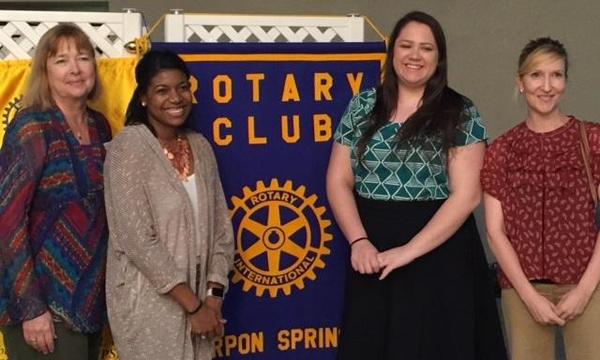Flowers along the Columbia River
_______________________
Before Claire Ranit spoke to her local Rotary Club, she needed to know if her listeners would be elephants or riders.
Ranit, MARC project director in the Columbia River Gorge region (pictured above), was referring to a model of behavioral psychology outlined by psychologist Jonathan Haidt in his book, The Happiness Hypothesis: Finding Modern Truth in Ancient Wisdom. In Haidt’s metaphor the conscious mind is a rider on the back of an elephant, while the elephant galumphs along on instinct and impulse.
“The elephant is a big, powerful animal—the emotional side of things,” Ranit explains. “The rider is the analytical piece that makes decisions and guides the elephant where it needs to go.”
A Rotary member who joined Creating Resiliency in the Columbia River Gorge through her work with the local chapter of Big Brothers Big Sisters advised Ranit that her audience would include more elephants than riders.
“I said, ‘What would be good? Is this group interested in facts? In stories? How do I present the information to them?’” Ranit says. “She helped me better understand the group, and I developed a presentation based on her feedback.”
That meant steering away from a data-heavy approach more in sync with her own “rider” temperament and focusing instead on the values and commitments of Rotary members: truth, fairness, good will, community benefit. “I could tie all those back to being trauma-informed and building resilience,” Ranit says.
She presented to the Hood River Rotary in August 2016, followed by similar talks with a Lions Club, a different Rotary chapter and Soroptimist International of Hood River—audiences ranging from 15 to 75 people.
Ranit used already-established relationships to get in the door. “As I talked to people about the goals [the MARC project] had, I’d ask, ‘Do you have any connections with people at Rotary or Lions Club?’” She also reached out through the local Chambers of Commerce.
The Rotary group included a range of business people: farmers and orchard owners, real estate brokers, people working in tourism. Ranit knew she had to answer the “why does this matter?” question. “I talked about how trauma and adversity are an inherent part of human life, how your staff will no doubt have experienced some form of trauma and adversity, as will the people you encounter.”
Ranit discussed the impact of trauma-informed approaches on staff wellness and retention, and how ACE-awareness could ultimately affect a business’s bottom line. “They responded really well,” she says. “They had a lot of questions; some members came up afterwards and wanted to attend the [October] Trauma and Resiliency Summit or participate in Sanctuary training.
After her presentation at the Hood River Rotary, the city manager approached Ranit to ask how he could get the entire police department trained in mental health first aid. The Soroptimists asked if Ranit could return for a second training. “To get that engagement after a 20-minute presentation showed how much ground we can make just through education,” she says.
In all her presentations—whether to service clubs, educators or community health workers—Ranit emphasizes the need for a fundamental shift in perspective, from “what’s wrong with you?” to “what happened to you?”
“I also talk about how a lot of the work they do is already resilience-building activity. I give encouragement and praise. Sometimes when we present information about ACEs and trauma theory, people get overwhelmed: Where do we even start? Saying, ‘Hey, there are already a lot of great things happening’ makes it less scary.”
Peace4Tarpon leaders have also found fruitful connections with their local Rotary Club in Tarpon Springs, FL. MARC project manager Wendy Sedlacek and Peace4Tarpon founder Robin Saenger presented at a Rotary meeting; later, the Rotary president attended the network’s monthly open-to-all gathering. And when Jasmin Williams—coordinator of Resilient KC, a partner initiative of the Greater Kansas City Chamber of Commerce and Trauma Matters KC—visited Tarpon, she joined a Rotary Club luncheon to talk about her city’s efforts to include business leaders in resilience-building work. Recently, the Tarpon Springs Rotary gave Peace4Tarpon a $200 grant to create a children’s art therapy program, matching a grant from the Unitarian Universalist Church of Tarpon Springs.

Pictured (L to R): Robin Saenger, Jasmin Williams, Emily Luft, and Erica Immenshuh at the Rotary Club luncheon in Tarpon Springs, FL.
Ranit says the next steps with service organizations in the Columbia River Gorge are similar to forays with any group embarking on a trauma-informed approach. “It’s making space for them to engage with the work at whatever level they can,” she says. “Helping them identify the issues they can influence and a plan to do that…There are a lot of people who want to do good work. We need to just dive in and figure out what works and what doesn’t: with best intentions, in a trauma-informed way, and with the knowledge that some things are going to fail, and that’s okay. We’ll learn from it and make it better the next time.”
Resources:
See a sample presentation and one-pager for service clubs from Creating Resiliency in the Columbia River Gorge’s MARC project director Claire Ranit.
You don’t have to use the language of ACEs and trauma to be part of the resiliency movement! Examining the core values of potential partners can help you identify opportunities for alignment.
Check out Rotary’s Guiding Principles.
Share Your Learnings:
Are you engaging service clubs to mobilize action for a just, healthy and resilient world? Tweet your #SharedLearnings to @healthfedMARC!
The MARC Shared Learnings series is currently exploring the unconventional partnerships that lend power to ACE & resilience networks. In this piece, we take a closer look at how communities are engaging service clubs.
Read about other partnerships in the series, including:
- Artists in the ACE and Resilience Movement: Creative Avenues to Change
- Business Leaders in the ACE and Resilience Movement: A Different Kind of Bottom Line
- First Responders in the ACE and Resilience Movement: Addressing Secondary Trauma and Building Community
- Youth Leadership in the ACE and Resilience Movement


Comments (0)